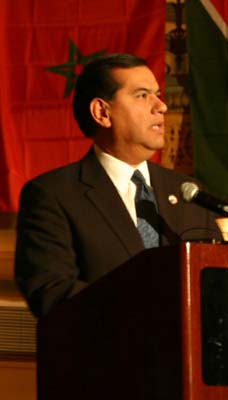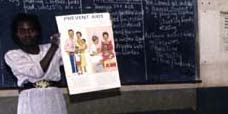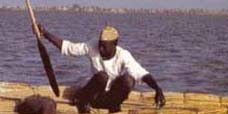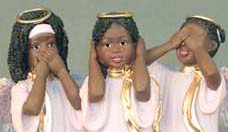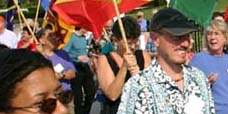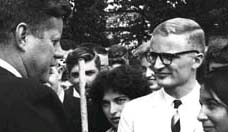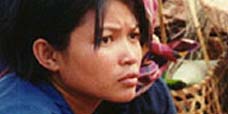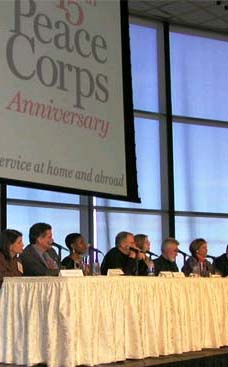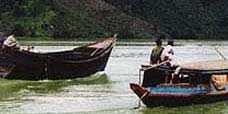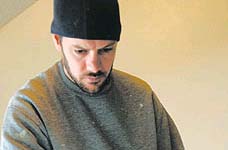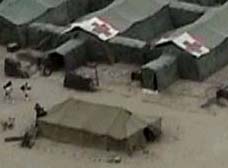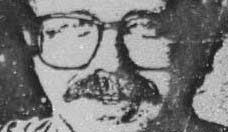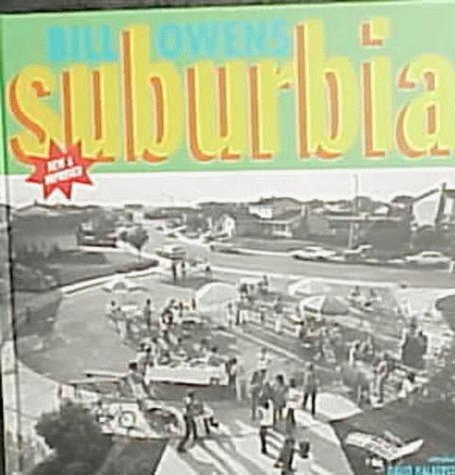
Bill Owens jumped to fame as a photographer with the publication of his book Surburbia in 1972. Owens had taken up photography while working as a Peace Corps volunteer in Jamaica. He went back to college, then worked as a photographer at a paper in Livermore, where he spent 11 years taking pictures of his community. "I thrived on the newspaper job," he says. "Newspaper work is the best discipline. You're shooting every day. That's the best entree to society. You go everywhere, all the time. Journalists see lots more of life. Cops and firemen see the negative parts of life. Journalists see positive and negative."
Photographer Bill Owens roams, but keeps coming back to suburbia
The eye next door
*Photographer Bill Owens roams, but keeps coming back to suburbia.
By Michael J. Ybarra, Special to The Times
Hayward, Calif. — On a bucolic street in this suburb (what else?) south of San Francisco, Bill Owens lives in a cottage crammed with art, mementos and the detritus of enough half-started projects — vintage pickup truck rebuilding, sparkling winemaking — to full several lifetimes. Somehow the human skull sitting atop a shelf doesn't look out of place.
"Don't ask me where I got it," says Owens. "I used to have an antique store. I can tell you where I got the cannonball, though."
ADVERTISEMENT
A typical Owens story starts with "I once worked as a .... "
"I've failed at a lot of things," Owens says. "I've tried a lot of things. Eventually you move on. I'm fearless."
Sometimes he tries things twice — such as documentary photography, which he passionately pursued in the 1970s, winning praise for his images showing how Americans lived in suburbia, but then he gave up photography in favor of making a living.
Several years ago, Bay Area collector Robert Shimshak asked Owens about his famous photos. Owens pulled a box of prints out from under a bed and said take them. Shimshak did, showing them to art dealers and curators, and the result has been a resurgence in Owens' career, with gallery shows from New York to Spain, numerous publishing projects and brisk auction sales. And he didn't even have to die for the attention.
"People think I'm dead," Owens says.
Evidence to the contrary can be seen at the UC Berkeley Art Museum, where a selection of Owens' work — old and new — is on display in a group show called "Dreaming California" (through May 21).
The exhibition — which also features the work of two other Bay Area photographers, Ruth-Marion Baruch and Larry Sultan — explores the shifting social norms of America in the second half of the 20th century. Baruch documents the change of fashions from San Francisco's Union Square shopping mecca in the early '60s to the city's hippie epicenter of Haight-Ashbury near the decade's end. Sultan's work juxtaposes a series about his semi-retired parents living in the San Fernando Valley in the 1980s and a return to the area two decades later to document the porn industry thriving in suburbia.
Owens' part of the show includes work from several of his books and recent short digital movies, such as 22-second clip about a woman carrying a tiny Nicole Miller purse and displaying its contents.
"Bill's more recent work is curious," says co-curator Gary Bogus. "He's quite excitable and full of energy. Pop culture is his forte and that's what he envelops himself in."
Owens was born in San Jose in 1938. He flunked out of college, then hitchhiked around the world in 1960. In a world before Lonely Planet guides, he stretched $900 into nine months on the road with his girlfriend.
"I made Janet [the two later married] give blood when we ran out of money," he recalls. "I had to borrow $300 to get home. I look at my notes — whorehouses and diarrhea."
Owens returned home, joined the Peace Corps and served in Jamaica, where he picked up photography. He went back to college, then worked as a photographer at a paper in Livermore, where he spent 11 years taking pictures of his community.
"I thrived on the newspaper job," he says. "Newspaper work is the best discipline. You're shooting every day. That's the best entree to society. You go everywhere, all the time. Journalists see lots more of life. Cops and firemen see the negative parts of life. Journalists see positive and negative."
That newspaper work led Owens to his first book, a photographic study of suburban California called (what else?) "Suburbia." First published in 1972, "Suburbia" established Owens' reputation as a keen and sympathetic observer of the daily rituals of life amid tract homes. He showed his neighbors watering lawns, grilling steaks, throwing Tupperware parties.
Some of the images hinted at a dark underside to suburbia, such as a photo of a child riding a Big Wheel, holding a toy gun and scowling at the camera. You might expect to see such a picture accompanying a story about a serial killer when he's eventually caught. But decades later when Owens revisited the neighborhood, he took a picture of the grown boy astride his Harley — and the image was less about biker malevolence than a man's lifelong love of toys.
"I thought 'Suburbia' was a wonderful, critical glance at the middle class, a great ironic view," says Bogus. "But we misread it. Bill really loved this community. He wasn't ironic; he was just curious. It's a quite embracing view."
Owens published two other volumes of visual anthropology, one on the various sorts of groups people join ("Our Kind of People"), another on jobs ("Working"). He won a Guggenheim Fellowship and two National Endowment for the Arts awards.
In 1978, Owens quit the newspaper business and tried freelancing. After three years he decided he liked feeding his wife and two children too much to continue that impecunious existence.
"I've been awarded everything there was," he says, "but I couldn't translate those skills into dollars. I didn't go into the business to make money. I went into it to change the world, and you can't sell out. My responsibility was to my family. I moved on."
So he sold his cameras and chose a more practical career: making beer at home.
Owens opened a brew pub called Buffalo Bill's Brewery not far from his home, and expanded his suds empire to two other locations. He also published the American Brewer magazine. Five years ago, he got out of the beer business, selling the pubs and the magazine, although he is still president of the American Distilling Institute, which promotes independent spirit makers, another of his passions.
"When I was in the brewery business the focus was on beer, not selling food," he says in the same tone that Leonardo might if he walked into a modern museum through the gift shop.
Out of the beer business, Owens purchased a digital camera and plunged back into photography.
"It made photography fun," he says. "I could shoot for free. I just fell in love."
In 2004 he finally published a new book called "Leisure," looking at how Americans spend their free time. Since then there's been a renewed interest in his work. A few years ago, for example, Owens sold a set of prints for $15,000. Recently the same set resold at auction for $75,000. "Someone made money on that work," he says.
These days Owens is as busy as ever, photographing everything around him. Trying to sit down for an interview, he fails, repeatedly jumping up to dig through project folders, or show off some image.
"I'm doing five books at the same time," he says. "I bore easy. From 6 in the morning until my eyes fall out, I just focus on the books."
The projects include a new look at suburbia, a memoir, a science fiction novel, and a photo book about food (look down at your plate about halfway through lunch and you'll get the idea). "My whacked-out food shots," he says. "You won't believe what we eat."
Although he does the occasional magazine assignment, Owens mostly just takes photos of whatever interests him, which is everything.
"I'm afraid of commercial work," he says. "It takes my time away, and the only thing you have is time. We all have these glass windows we fly up against in life. I don't need much money. I can't do it for the money. I only shoot for my own passions."
